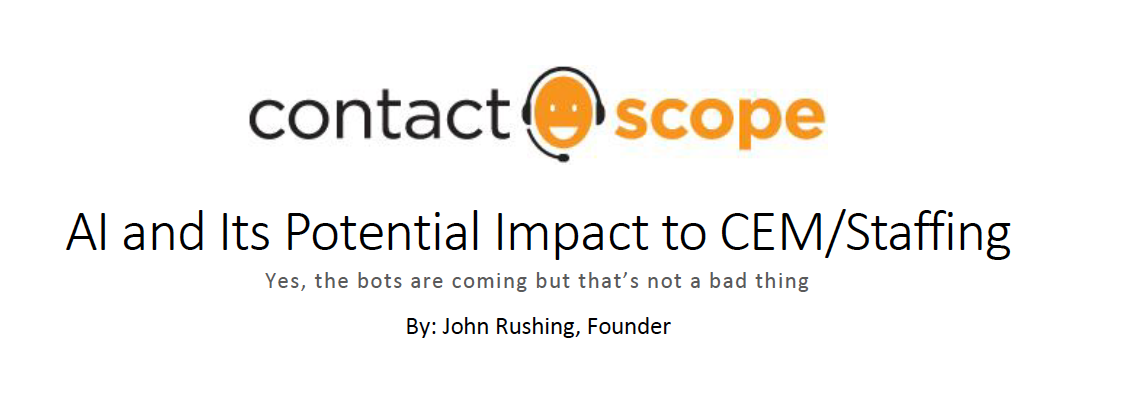
Introduction
Before I begin, let me encourage you to watch and listen to a demonstration conducted during Google’s annual I/O developer conference just a couple of weeks ago. The actual video of the event is about ¼ the way down the page and is labeled “Google Duplex Demo from Google IO 2018”. Chances are you’ve seen this given the press and debate it has engendered in the industry, but please watch again before continuing.
The relevant part of the demo for this discussion begins at about 2-minutes and 43-seconds into the video. The interaction is a live call initiated by an AI ChatBot to a restaurant where a woman answered the phone. She had no idea she was speaking to a machine.
https://newatlas.com/google-duplex-controversy-ai-sounds-too-human/54579/
Since the conference, there has been a great deal of debate about AI, along with many concerns about the ethics of having AI/NLP-based (Artificial Intelligence/Natural Language Processing) ChatBots that are capable of understanding and emulating human voice and speech patterns so incredibly well. I won’t weigh in on that topic here but do ask you, the reader the following;
“If you were the person calling into the restaurant to make an important reservation, would you have preferred to speak with the human in the demonstration or the ChatBot?”
I think that most of us would say that under any circumstances, we would have preferred the ChatBot. The person who answered was having trouble understanding the caller; at no point in the conversation did the person that answered demonstrate that she understood the date of the requested reservation. The ChatBot had to repeat the number of people and date/time repeatedly. Finally, the person told the caller (the ChatBot that is) that if it was fewer than five people, they could just show up.
While this was for a restaurant reservation, we all know this happens all the time for much more important tasks like making doctor appointments, making airline or hotel reservations, paying your cable or phone bill and countless other day-to-day and relatively simple interactions between customers and the companies they do business with.
Further, it is happening with both high-value and lower-value customers equally. There will almost certainly be continued debate around ethics and application of AI-ChatBots but in the end, AI will make its way into Contact Centers and Customer Experience Management more broadly and this will undoubtedly impact jobs as well as customer experience for the unprepared. The only real question is how can companies can prepare for it.
Preparing for the Future of AI in Customer Experience Management
The great news about positioning your company to deal with the future of Customer Experience Management and ChatBots is that you don’t have to do anything that your organization shouldn’t be doing anyway. Despite the fact that I consider myself to be a “technologist” in most respects, I have worked in and around Contact Centers of every description for over 25 years. In that time, I have learned that while technology provides the tools and in some cases the means to deliver services, how services are offered and how effectively they anticipate and address the needs of customers are driven almost entirely by business processes, training, management and operational factors; not the underlying technology.
The best way to ensure effective, consistent and continuously-improving experiences to their customers is for companies to make real investments in their Contact Center personnel. By this, I don’t just mean appropriate compensation and benefits, which are obviously important. Here I am referring to the less tangible things like;
- Effective training and coaching,
- Providing clear and compelling career paths,
- Making every attempt to hire from within first and if you can’t do that consistently, asking why
- Actively enabling, supporting, and encouraging employees to develop the skills needed to advance both their position in the center and their careers more broadly
I firmly believe and have personally seen what happens to Customer Experience when companies take an active interest in ensuring that they create a work environment where the agents know that the company that employs them values their work. I also know that executives and managers at every company cannot afford to boost compensation for a lot of different reasons but the other actions mentioned don’t necessarily require significant capital investments. They can in many cases be achieved by making adjustments to training, quality, and management practices in and around the Contact Center.
Last year I visited a company outside Seattle with a business partner. It is a public company with about $400 million in revenues annually. The interesting thing was that the CEO sat in a cubical in the Contact Center. The CEO’s direct reports also had cubicles distributed throughout the Contact Center. While I am not recommending that every CEO and company do this, the impact that I believe this had on his team was probably incalculable. It certainly didn’t cost the company more to have the CEO in a cube along with his direct reports and the rest of the contact center staff. In fact, it almost certainly saved money. But, this type of action on his part sent a clear message to his employees from the newest new-hire to the most senior executive that Customer Experience matters and “we” are all responsible for it. As you might imagine, employee retention in this organization was unusually high and not just because the CEO and his executive team respected their employees. In short, people and organizational ethos drive customer experience; Not technology.
So What Does This Have to do With AI?
Optimistically speaking, and across all industries and markets, attrition rates in Contact Centers are about 15%. Many companies are much higher than that of course. In most companies, attrition tends to be highest within the first 3-12 months of employment either because the new-hire simply wasn’t a good fit and left voluntarily or because they had to be let go to make room for other new-hires who were excelling at the same skills.
If a company chooses to invest in its employees as I mentioned previously and particularly if employees are encouraged and supported in their advancement to more highly-skilled positions in the Contact Center and/or company, the natural tendency will be for the best Contact Center staff to go up (because the company is also hiring from within) and the people behind them will move up to fill their positions. This leaves the lower-skilled jobs that need to be filled.
When AI hits, and it will, it is almost certain that the first applications or targets for the technology are going to be the more simple, repetitive tasks that are typically handled by lower-skilled agents. These tasks are often responsible for 65%-75% of the total work done in centers by the number of contacts/interactions. Since the company is retaining and promoting its more highly-skilled people and has a process to pull everyone else up behind them, the staff most affected by AI are most likely going to be the lower-skilled ones. While some of these jobs at this level may be lost, between natural attrition, effective personnel policies, and planning these losses can be minimized.
On the other hand, if companies choose to wait until AI is forced upon them, they will find themselves in positions where they are will have to lay off large numbers of workers. This is going to impact morale throughout the Contact Center and will inevitably affect customer experience if the staff serving the company’s customers are left feeling demoralized.
The single most important assets to any company that operates Contact Centers are the people behind the computer screen or headset. This was true in the past, is true now, and will continue to be true for the foreseeable future. It is unlikely that ChatBots will completely replace humans in Contact Centers anytime soon, but no matter what a company does or how it uses its Contact Centers today, the bots are coming. Some companies will be early adopters, others will wait and join the pack later, but within 6-10 years (probably closer to 6) AI will be firmly entrenched in most facets of customer experience operations.
Preparing now is merely a practical business decision. Particularly when most of the steps you can take will benefit your employees and ultimately your customers both today and in the future no matter what happens with AI.

